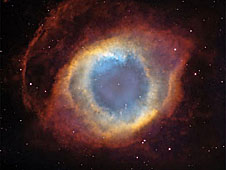- NASA Home
- > Education
- > For Students
- > Grades K-4
- > Stories
Feature
Text Size
What Is the Hubble Space Telescope?
05.04.10

The Hubble Space Telescope makes one orbit around Earth every 97 minutes. Image Credit: NASA.
View Larger Image →
Hubble faces toward space. It takes pictures of planets, stars and galaxies. Hubble has seen the birth and death of stars. It has seen galaxies that are billions of light years away. Hubble has also seen comet pieces crash into the atmosphere above Jupiter.
Scientists have learned a lot about space from Hubble pictures. The pictures are beautiful to look at, too.
What Makes Hubble Different From Telescopes on Earth?
The atmosphere above Earth changes and blocks some of the light that comes from space. Hubble orbits high enough above Earth to avoid this problem. Hubble sees space better than telescopes on Earth.

The Hubble Space Telescope took this picture of the Tadpole Galaxy and its tail of large, bright blue star clusters. Image Credit: NASA
View Larger Image
Hubble is named after an astronomer. His name was Edwin P. Hubble. An astronomer is someone who studies the planets, stars and space. Edwin P. Hubble made important discoveries in the early 1900s. He found many galaxies in the universe. His work also led to the idea that the universe was getting bigger, as if from a big explosion. Scientists call this explosion the big bang. The explosion would have happened billions of years ago.
What Are Hubble's Most Important Discoveries?
Hubble pictures have helped scientists guess the age and size of the universe. Scientists think the universe is about 13 or 14 billion years old. Hubble has also helped scientists understand how planets and galaxies form. A picture called "Hubble Ultra Deep Field" shows the farthest galaxies ever seen.
Hubble has spotted black holes. Black holes suck in everything around them, including light. Hubble has also helped to discover dark energy. Dark energy is a strange force that causes the universe to expand faster and faster as time goes on. And Hubble has helped scientists learn more about explosions that occur when huge stars die.

This colorful image of the Helix Nebula was taken by the Hubble Space Telescope. Image Credit: NASA
View Larger Image →
Servicing Mission 4 is the name of the space shuttle mission to repair the Hubble telescope. This will be the fifth time astronauts have visited Hubble. During this mission, astronauts will put two new instruments on Hubble. They will also fix two broken instruments. Scientists hope this work will keep Hubble running for at least five more years.
Where Do the Colors in Hubble Pictures Come From?
Hubble pictures start out as shades of black and white. Colors are then added to the pictures. Colors can help show how an object might look to the human eye. Colors can also be used to point out an important detail in the picture. Or they can help to show details that the human eye wouldn't see.
Where Can I See More Hubble Pictures?
HubbleSite Gallery →
NASA's National Space Science Data Center Photo Gallery →
More About Hubble:
NASA's Main Hubble Page →
HubbleSite →
What Is a Black Hole?